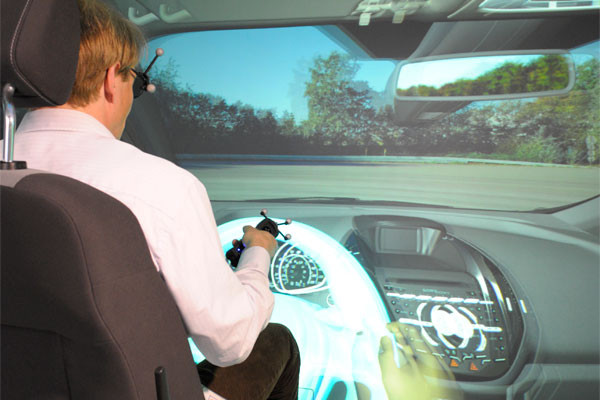
Ford significantly accelerates Vehicle Development Processes using IC.IDO

The Ford development process for vehicles is getting faster and faster. ESI’s Virtual Reality solution IC.IDO is an efficient tool to reduce the amount of prototypes and mock ups. We can build several virtual vehicles in much less time and at lower cost than the usual expensive and dated prototypes and fixtures. IC.IDO enables us to verify different design alternatives. It also allows us to conduct attribute assessments in earlier stages of the program and escalate and visualize of any issues, be they simple or very complex!
Michael WolfVirtual Reality Supervisor / Ford
The automotive industry worldwide continually faces great challenges in product and process development. Due to the increasing number of models and variants the market demand shorter and shorter development cycles. As a result, the use of virtual engineering and virtual technologies is becoming more and more necessary in product development to support styling, engineering and production. Globalization has led to a permanently growing pressure from competition and a significant margin squeeze phenomenon. In addition, industrial customers request more and more innovation and individualization, which makes the product range very complex to manage.

To be able to face these challenges, Ford decided to invest in technological innovation and to integrate ESI’s Virtual Reality solution IC.IDO in its Product Development Processes. Today, Ford has five IC.IDO Virtual Reality installations in Europe and in the United States. In Cologne, Germany, Ford's team uses the system to manage product development and engineering.
Ford's first IC.IDO installation in 2006 was at the John Andrews Development Center in Cologne-Merkenich. Following this first experience, they decided to integrate ESI’s Virtual Reality solution as the “Vehicle Engineering” department cornerstone. Since then Ford has been using IC.IDO on this site to support Product Engineering Processes (PEP).

Stereoscopic multiple walls immersive visualization system used in the ergonomic assessment of a car cockpit. Ford’s objective was initially to use Virtual Reality to enhance workload distribution, to optimize processes and collaboration, to perform simultaneous engineering, and to decrease the number of physical prototypes.
Ford’s concrete applications of Virtual Reality
Ford’s Cologne-Merkenich Development Center uses Virtual Reality for aesthetic visualization. In a four-sided cave, the Driving Environment department validates perception and appearance.
Such a high-end projection system combined with intuitive interaction facilitates the assessment of the perceived product quality. The user visualizes the vehicle from his or her viewpoint.

IC.IDO also allows the Ford team to verify ergonomic aspects. Visibility assessments using reflection analyses from the user's viewpoint together with reachability and operability studies utilizing a seating buck are part of regular engineering studies and milestone reviews. The “Virtual Seating Buck”, as Ford has named it, allows them to assess multiple aspects, from visibility to veiling glare, roominess, stowage, craftsmanship, design, and ergonomics.
The use of Virtual Reality intervenes very early in the vehicle engineering process. Indeed, Ford established the use of IC.IDO thirty-seven months before the start of production.
ESI’s Virtual Reality solution helps Ford save costs,reduce development time and accelerate processes
How does Ford achieve a real cost reduction with Virtual Reality? Early use of IC.IDO allows Ford to eliminate the majority of errors in the early phases of the project, avoiding expensive failures and late change-related costs.

Ford also takes advantage of ESI’s Virtual Reality solution to reduce both the cost of new product development and time-to-market. Indeed, creating a physical mock-up of a seating buck can take between six and eight weeks and is prohibitively expensive.
To gain time, the different phases of the product development process need to overlap. Virtual prototypes visualized and manipulated with ESI’s Virtual Reality solution enable frontloading thanks to an earlier understanding and try out of the product.
Reducing time-consuming iteration loops also allows Ford to save time.
The ability of automotive OEMs to visualize their design concepts and vehicle layout prior to production is revolutionary. Worldwide collaboration and communication as enabled by Immersive Virtual Reality make this technology the future of engineering and manufacturing.

About Ford Motor Company
Ford Motor Company, a global automotive industry leader based in Dearborn, MI., manufactures or distributes automobiles across six continents. With about 172,000 employees and about 65 plants worldwide, the company’s automotive brands include Ford and Lincoln. The company provides financial services through Ford Motor Credit Company.
For more information visit Ford Motor Company